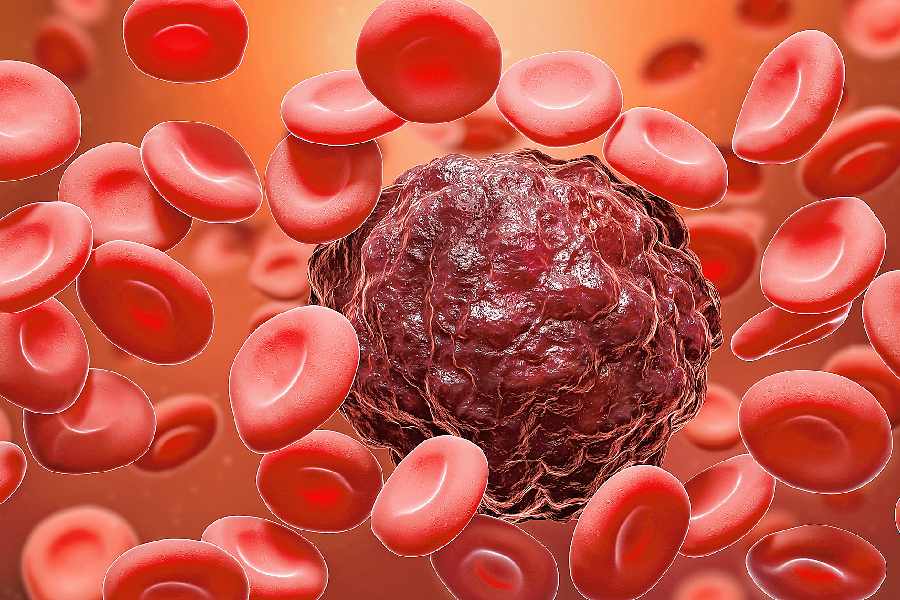Some scientists hail this molecule as the “poster child” of cancer therapy. Cancer patients, whose days were numbered until the drug was launched in India, 20 years ago, call it a “wonder drug”. And many haematologists and oncologists who have seen patients die from stronger yet far less effective chemical therapies hail it as the “magic bullet”.
The molecule is called Imatinib. Its precursor was STI571. Chemists of a now-defunct Swiss pharmaceutical firm Ciba-Geigy (it merged with Sandoz in 1996 to form Novartis) had synthesised it along with many other mole-cules while looking for a new anti-inflammatory drug. Rather serendipitously, however, they discovered it could also block the activity of some fatal enzymes. But since the scientists concerned as well as drug company bosses hadn’t decided what exactly to do with the compound, they simply tucked the molecule inside their “drug library”.
The drug, invented possibly in the early-1990s by a team of scientists led by British biochemist Nicholas B. Lydon, would have remained hidden in the refrigerator for eternity, had it not been for an American oncologist. In 1993, Brian J. Druker requisitioned the drug from the Oregon Health and Sciences University (OHSU), US.
Philadelphia Chromosome
Druker, a medical doctor-cum-scientist, had been studying how cells burst into runaway growth, also known as cancer. His focus was certain enzymes and proteins that change other molecules by breaking them down (gut enzymes, for instance, help break down complex molecules in our food). Druker, a young faculty member at OHSU, had mastered intricate techniques for tracking andmeasuring enzymes in tissue samples, especially in a type of blood cancer called Chronic Myeloid Leukaemia (CML).
A curious chromosomal aberration existed in every CML patient. This aberration created an enzyme responsible for the uncontrolled growth of white blood cells (WBCs) — the blood component responsible for fighting infection in our body.
The unusual chromosomal pattern, first discovered by two pathologists based in Philadelphia in the 1950s, was known as the Phila- delphia chromosome. Normally human cells have 46 chromosomes — 23 matched pairs, one from each parent. But in the case of Philadelphia chromosomes, found in CML patients, the tail of the 22nd chromosome gets lopped off and attaches itself to the head of chromosome 9. The freakish gene, called BCR-ABL, formed during the birth or division in the stem cells in our bone marrow, keeps on churning out tyrosine kinase, a renegade enzyme. Unlike its sober twin that controls WBC production, the evil enzyme turns on the switch of uncontrolled cell division, spurring the runaway production of WBCs in the bone marrow.
Mystery Mutation
Why the quirky BCR-ABL fusion of genes happens still remains a mystery, but scientists are sure that the mutation isn’t passed from parents to children. Some of the causes are exposure to high-dose radiation and intense exposure to low-energy radiation from electromagnetic fields.
Recent research points out that exposure to certain pesticides and industrial chemicals like benzene, toluene and xylene might cause various types of blood cancer.
One of the reasons why scientists at Ciba-Geigy put aside the molecule STI571 was that in the 1990s, barely 5,000 patients were diagnosed with CML per year in the US or Europe, the most potential market of the drug. In other words, they felt the drug may not turn out to be a blockbuster drug.
The market-driven pharma firm didn’t have the foresight that increased chemical and radiation exposure worldwide could increase the global incidence of CML to one in every 50,000 people by 2017. Neither did they sense that the drug could open up a new horizon for the so-called targeted therapy in the burgeoning world of cancer patients.
Targeted Therapy
Druker, who had been studying the tyrosine kinase, surmised that if one can directly target the crazy BCR-ABL gene, it can be forced to be blocked from producing the villainous enzyme. This could put a stop to the runaway growth of WBCs. In the process, CML can also be checked from progressing towards a fatal stage. He reasoned that because healthy cells do not have BCR-ABL, they should not be affected by such a treatment.
Druker sensed that such “targeted therapy” could disable the critical enzyme and spare normal tissues. The prevalent treatment modalities, such as those involving interferon, radiation therapy and powerful chemotherapeutic drugs, carpet bombed all cells — cancerous and healthy — eventually turned counter-productive, hastening death. As a last resort, doctors would suggest bone marrow transplant (BMT) — in which a patient receives healthy blood-forming “stem” cells when his have been destroyed by destructive therapies. But the success rate with BMT — an expensive modality — was below 50 per cent.
Druker saw how “miserable” life was for CML patients who often arrived at his clinic with an enlarged spleen. Sometimes, patients got alerted accidentally during routine blood count tests. It was difficult as both “he and the patient knew the clock of death was ticking” and there was virtually “nothing he could do”.
A Legal Wrangle
So when Druker got wind of a potential molecule he got in touch with the Swiss pharma company to dispatch it to his lab. But the new company was caught in the changeover.
It took months before Druker could pour a few drops of STI571 into a petri dish filled with live WBCs extracted from the bone marrow of a CML patient. Druker had expected the “inhibitor” chemical at best would impair the cells’ growth, but he found that the cells died overnight. He was wonderstruck. He had laid hands on a new genre of drugs called “tyrosine kinase inhibitor” (TKI), the harbinger of targeted cancer therapy that would someday be tried on many types of cancer.
But there were naysayers aplenty. They refused to believe that the TKI would work in live animals and humans suffering from CML. The drugmaker also hesitated to take its trial any further. Druker, however, continued to persist. He and some like-minded colleagues pushed the US drug regulator (FDA) to try it on dying CML patients who readily volunteered for clinical trials.
In December 3, 1999, Druker announced to an auditorium full of haematologists in New Orleans that 30 out of 31 patients in the drug trial responded favourably to STI571. He also mentioned the side effects — termed “mild to moderate”, such as upset stomachs, muscle cramps and sleep disturbance by scientists and doctors.
The praises poured in. The biggest accolade was from Harold Varmus, who was then the head of the US National Cancer Institute and later awarded a Nobel prize for doing some of the groundwork for STI571’s success.
Magic Bullet
The drug and its improved versions are now used in many blood cancers and even solid tumours.
It was 2001 and Dr Tuphan Kanti Dolai, head of the department of haematology at Calcutta’s NRS Medical College and Hospital, had just graduated from medical college when STI571 was converted into an oral pill as Imatinib Mesylate. It was launched as Gleevec in the US drug market. The haematologist says, “The drug was launched in India in 2003. But since it was prohibitively expensive, the company offered free samples for patients at our hospital.”
Those days, CML was still considered a rare disease. Says Dr Dolai, “Today CML is the most prevalent type of blood cancer in the country’ it also affects lakhs worldwide... For them, the generic version of the drug, Imatinib, isa lifesaver.”
There are many Indian drugmakers who produce generic equivalents that are available for free or at subsidised rates to CML patients in government hospitals.
Dr Rabindra Kumar Jena, head of haematology at Cuttack’s SCB Medical College and Hospital, says, “Imatinib has turned an untreatable blood cancer into a manageable disorder like diabetes or hypertension. Around 80-90 per cent of the patients who can take the medicine regularly find their disease arrested.” He has already treated over 5,000 patients and the results are dramatic.
According to him, the drug is also working wonders for various other types of blood cancers. “Haematologists are specialists best equipped to manage the treatment as the side effects usually affect other blood components,” he adds.
Druker, who is 68 now, and was awarded the American Nobel Prize (Lasker-DeBakey award) along with Nicholas B. Lydon for “converting a fatal cancer into a manageable condition”, receives at least one mail a week from a patient who has survived because of his research initiative.
Apart from bringing the drug into the market, his other battle has been to help the drug reach the poorest patient suffering from cancer. He hasn’t “earned a penny” in royalties for his research.
A Calcutta-based patient — who doesn’t want to disclose his name — sent a thank you email to Druker on World Blood Cancer Day on May 28.
Druker replied, “I am glad you are doing well… I have worked with non-profit organisations that provide medications for patients with CML worldwide… but they don’t have the resources to reach everyone in need, but at least it helps some.”










